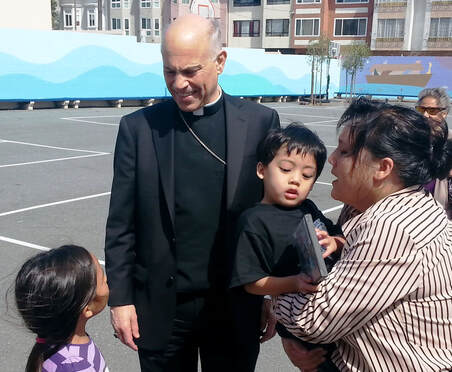 Lorna Feria offering her son, Fergus, for an Archbishop's blessing while His Excellency himself is distracted by Fergus' sister, Anna, who happily prattles to the prelate.
Lorna Feria offering her son, Fergus, for an Archbishop's blessing while His Excellency himself is distracted by Fergus' sister, Anna, who happily prattles to the prelate.
 Lorna Feria offering her son, Fergus, for an Archbishop's blessing while His Excellency himself is distracted by Fergus' sister, Anna, who happily prattles to the prelate. Lorna Feria offering her son, Fergus, for an Archbishop's blessing while His Excellency himself is distracted by Fergus' sister, Anna, who happily prattles to the prelate. Isolation on earth is hell, and hell is isolation: to be cut off, to feel the terrifying emptiness of rejection, to sense that one’s own mother and father have no interest in one’s life. The overused word “exclusion” and the contemporary acronym FOMO (“fear of missing out”) manifest this essential fear of being left out. As healthy social structures collapse (especially the family and the “village”), technology promises to fill the vacuum. Corporations that are making lots of money on our loneliness tell us that a smartphone “connects” us to others. And yet, we are a city of isolated single people. Might I recommend a better way: religion. Of course, religion has a bad name these days, especially when some religious leaders are revealed as the most isolated of all people. But consider the very meaning of the word. “Religion” comes from the Latin re-ligare, literally to “re-tie” (“ligare” means to attach or connect, as in “ligament”). True religion reconnects us with God and each other, but it too has a cost. We must spend an hour in Church, in the presence of God and other people. We must also spend time and money on the “Domestic Church,” meaning Mom, Dad, and the children. If you don’t yet have a family (and God calls almost all of us to marriage), be faithful to some kind of godly community: a young adults group, a book club, a service group. Families, however, will always be the backbone of every village. I struggle every day to pastor a parish with so few families. The sense of isolation in our city parishes terrifies me. Every family is a treasure, which is why I am so grateful to those brave enough to get married and have children. The Feria family, for example, is a backbone to my church. Bud, Lorna, and their five children provide such a sense of stability. The Feria’s have never given up on each other, and, in a declining Catholic culture, they have been a radiant Domestic Church at Star of the Sea for thirty-five years. Their youngest, Fergus, just received his First Holy Communion and gratefully opens his mouth each Sunday to receive Jesus at the 9:30 Mass. May God bless us with many families like theirs! Ryan and Mary-Rose Verret are another family with five children. Authors of the Witness to Love marriage apostolate, they have given most of their adult lives to building up families. They will be staying at my parish this week while they speak to the Archdiocese and the famous Napa Institute. We are privileged to receive them!
I want to report on a curious phenomenon in the life of Catholic priests. We are issued a prayerbook upon ordination called “the breviary,” which we promise to pray faithfully every day. We carry this book, usually in a leather cover, with us everywhere, and many priests refer to it affectionately as "my wife." It is called the “breviary” because it is a “briefer” form of the monastic liturgical office. Monks pray from it eight times a day for a total of about three hours, while we parish priests commit to five times a day totaling about an hour. The first of these “liturgy of the hours” (the prayers punctuate our day, sanctifying the “hours”) is called lauds, or “praises.” We begin the day praising God. Lauds consists of three psalms, a scripture reading, the “Benedictus” from Luke 1, and the Pater Noster, among other scriptures. I’ve been praying these same prayers every morning for 30 years, and you would think they would bore me by now. But—and here’s the curious phenomenon—they grow more fresh and thrilling year by year. Why am I not weary of the same old words?
St. Augustine described Scripture as a limitless well. We peer into this well, we become dizzy gazing into the depths, and we never tire of discovering new beauty in these life-giving waters. Each morning the Scriptures in my breviary restore me to life. As I get older, a good night's sleep comes less easily. After a fitful night, who can face the day’s troubles? But every morning, no matter how difficult the night has been, the breviary recovers the joy of a new day. Each morning, in the words of the prophet Jeremiah, "His mercies are renewed," and each morning our praises are renewed with them. I can hardly believe my good fortune: I’ve been issued a device that restores my vitality every morning. Lauds only takes about ten minutes, and I usually pray it with the other priests in the church at 7am, but I can pray it anywhere, every day. Wherever in the world I am, simply taking that ten-minute soak in the Word of God restores the joy of my youth. We will run, and not grow weary, as the Prophet says in Isaiah 40:31. The Lord will renew their strength every morning, and they will soar like eagles. This is my personal experience of praying the breviary, and I find it amazing. 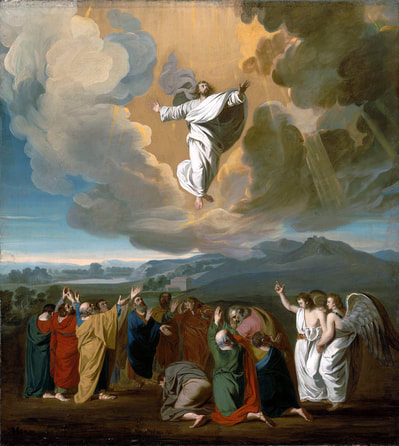 h/t: John Singleton Copley (1738–1815) via Wikimedia Commons h/t: John Singleton Copley (1738–1815) via Wikimedia Commons On Sunday eight gunmen on motorcycles arrived at a parish in Burkina Faso (West Africa) just as Mass was beginning. They killed four parishioners and wounded many more. Two weeks earlier six Catholics had been killed during a prayer procession in another village of that country, just a day after gunmen had killed four Catholics at third village during Sunday Mass. Christian martyrdom in our time is the highest it's ever been in history, with the low estimate at one Christian killed every hour for his or her faith, and the high number at one every minute (between 8000 and 100,000 Christians were killed for believing in Christ last year). Persecution, however, strengthens rather than eliminates Christianity. Roman governments tried to eliminate the Church over 300 years of bloody persecutions, but "the Roman Catholic Church" is still in Rome and the Caesars have long since gone. The Soviet government also tried direct persecution for 70 years, but that didn't work either. The current Chinese government’s attempts to suppress the Church through imprisonment and church demolition will also fail in the long run. In the United States, Christians do not shed their blood, but certainly the Church faces both external and internal opposition. From without, those who cannot tolerate the Church’s influence in the public square seek to suppress her activity through the legal system. New Jersey recently expanded the statute of limitations for abuse cases … but only for the Catholic Church. The California State Attorney has just demanded full documentation on abuse cases … but only from the Catholic Church. The lawsuits that will come from government and private attorneys will drain parishes of their operating funds until, it is hoped, the Church simply gives up and goes away. But this will not work, because the enduring dynamism of the Catholic Church is not in buildings and endowments. It is in faith, which has far greater staying power than politics and money. The Church will be reduced to a remnant, I suppose, over the next fifty years, but in contracting it will grow more intensely focused. The Church of the catacombs glows white hot with faith, because faith is all it has left. The Church is also undermined from within. Many weak and some malevolent clergy have diminished the Church’s influence by minimizing Catholic faith and practice. Catholics rarely hear clear homiletics on unpopular doctrines, and Catholic school students usually hear secular doctrines given equal weight to Church doctrine. How often have you heard clear preaching on artificial contraception or abortion? Homilies on tolerance, inclusion, social justice, and climate change are a lot more popular. Why is it that most Catholic school graduates cannot articulate the Church’s understanding of the human person? Most Catholics can easily parrot the party line on gender ideology but would be hard-pressed to explain Eucharistic theology or human anthropology. Many weak and some malevolent clergy have minimized Catholic faith and practice. Catholics rarely hear clear homiletics on unpopular doctrines, and Catholic school students usually hear secular doctrines given equal weight to Church doctrine. Most Catholics can easily parrot the party line on gender ideology but would be hard-pressed to explain Eucharistic theology or Christian anthropology. How can we strengthen our faith and rebuild the Church? This Thursday is Ascension Thursday, but most Catholics will not celebrate it or even think about this wonderful mystery, so fundamental to the Christian faith. The hierarchy has moved this mystery to Sunday, but most Catholics don't attend Mass even on Sundays, because the clergy has decided not to talk about missing Mass as a mortal sin. How can we regain our crumbling faith? You can do what my mother did: properly celebrate the Great Catholic Feasts. The bishops had already stripped our Ascension Thursday altars when I was a boy, but that did not stop my mother. She piled us into the old station wagon for a trip to the mountains. She had us pray the Mass prayers and readings before sitting on blankets under the blue sky to eat and play games. Ascension Thursday shone in my boy's heart, despite episcopal malfeasance, because of my mother. Ascension’s promise, that one day I too will be taken up to heaven, sustains my adult faith to this day. Thanks Mom! 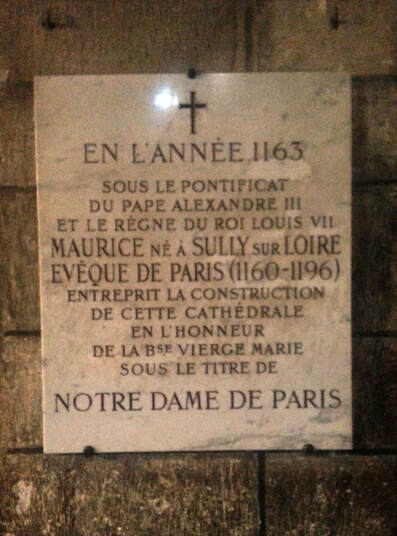 A snapshot I took of Bishop Maurice's memorial plaque on the wall of Notre Dame while on a Paris layover in 2014 A snapshot I took of Bishop Maurice's memorial plaque on the wall of Notre Dame while on a Paris layover in 2014 Rachel Fulton Brown weighed in on the Notre Dame fire yesterday, as probably hundreds of thousands have done over the last 36 hours, including your scribe in this blog post. Rémi Brague describes the fire as a kind of 9/11 moment for France. “Where were you when Notre Dame was burning?” I was hurriedly entering my church for noon Mass when an agitated knot of ladies tried to stop me. “Your church is burning!” one of them gasped. I looked up as I crossed under the transept towards the sacristy, but I didn’t see my church burning. And yet Notre Dame is my church, and a mother church for any who have stood beneath her wheeling Rose windows or caught a first glimpse of her buttressed towers from across the Seine. The Cathedral of Paris is the mother church, much as St. Peter’s is the father church, of Christendom and Western Civilization. A few years ago, I had a five-hour layover at Charles de Gaulle, which they call the “Paris Airport.” In fact, it’s a good hour on the fast train from downtown, but I figured I would have 45 minutes in Paris if I got through the immigration lines quickly. I went straight to Notre Dame, wandering through the semi-darkness, reading memorial wall plaques from 1163, watching young people make their confessions to priests waiting in the cathedral’s curious glass confessionals, peering into the smoked glass reliquary of the crown of thorns. And of course, standing before the great North Rose, feeling as if I were falling into eternity. Rachel Fulton Brown asks the question: why should we rebuild Notre Dame? Restoration donations have almost exceeded $1 billion, and we certainly have the technology. France’s agnostic President confidently declares the national monument will be rebuilt “more beautiful than ever” within five years. But can we build what the Faith of our Fathers built? Can we do what the medieval masons and glazing artisans did without their love for God, for Our Lady, for the Gospels they so winningly portrayed in glass and stone? “In the middle ages, it wasn’t the building of stone, glass, and wood that mattered,” Fulton writes. “It was the worship offered therein.” The most ordinary parish church becomes beautiful when people pray within it. Only faith in God and love for his Church can restore Notre Dame’s essential beauty. The burning of this monument is a national referendum for France: are we still Christian enough to rebuild a Catholic church? We priests have the unspeakable privilege of leading our communities in the Paschal Triduum over these next three days. While the highest liturgies of Christian worship will not take place in Paris’ cathedral this year, they will in every simple parish church, and in the modernist Cathedral here in San Francisco. What makes our lives beautiful is not stone and glass, but the depth of our prayer to God, the leap of the heart that looks up and into God, who is beauty itself. We all hope that Notre Dame can recover her essential beauty, but that beauty is ours for the asking right in our little parish churches, or even in our own rooms, if we enter deeply into the mysteries of these next three days. 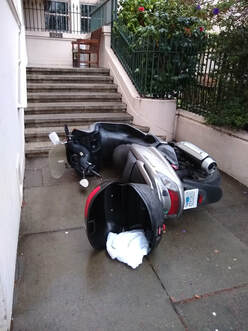 My parents gave me a brand new bike with banana-seat and sissy bar for my tenth birthday. I would ride it to school like a Corvette, ‘driving’ home for lunch with Mom and Dad occasionally. But one day a buddy ran up to me. “Hey, Illo, someone pushed over your bike!” I ran back with him to see my beautiful bike on the ground. My friend picked it up for me. On Thursday our maintenance man Dennis ran up to me. “Hey, Fr. Illo, someone pushed over your bike!” I ran with him to the front sidewalk, where I park my scooter. But someone had already picked it up for me! It was standing upright, although the left mirror was pushed in and the plastic frame bent out of shape. I display on this blog the picture Dennis had taken of it on the ground. Thursday was a hard day. The previous afternoon I had to inform my school faculty and parents of the Archdiocese’s decision to suspend most of our classes next year due to low enrollment. Over the past year some families have been expressing acute unhappiness over my decision to implement an Integrated Classical Program, and to further to integrate the school as a ministry of the parish. Unhappiness spreads quickly in a school, and most of the families ended up not enrolling their children for next year. The first thing that happened the day after announcing the suspension of classes was my scooter getting knocked down. The next thing that happened was the arrival of news cameras. They spent the entire day interviewing the acutely unhappy parents. Some want to make sure most of San Francisco is unhappy with Fr. Illo and his vision of a traditional Catholic school. A few weeks ago someone threw down our outdoor statue of Mary. Dennis, our ever-patient maintenance man, dutifully disposed of the shattered pieces. The vandal also threw a lovely potted plant onto the sidewalk, destroying plant and planter. We mourned the loss only two days, however, because on the morning of the third day a bright new statue of Our Lady had replaced it, along with a new plant. We don’t know who placed it there. Our benefactor remains anonymous, and I didn't even have to ask for a new statue. Otherwise tolerant people seem unable to tolerate Christianity these days. They are smashing Catholic statues and toppling Catholic institutions. But other people, quietly and anonymously, are stepping up to rebuild them overnight. 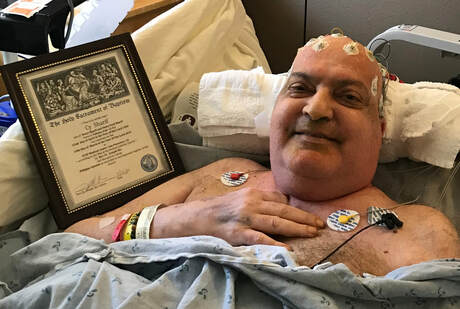 Cy Sharif in the University of California San Francisco Medical Center last week, with his framed baptismal certificate beside him. Cy Sharif in the University of California San Francisco Medical Center last week, with his framed baptismal certificate beside him. [Conversion story & photo used with permission] Lent is a time to prepare for Easter, but more than Easter, a time to prepare for baptism. Four adults in our community are preparing for this at the Easter vigil on April 20. Normally we don’t baptize even infants between Ash Wednesday and Easter Sunday but last week, on the Third Sunday of Lent, I baptized a man. Cy Sharif was born in Tehran but has been living in San Francisco many years. He is dying of cancer and quite scared of entering that undiscovered country from which no man returns. I’ve seen some inspiring conversions and adult baptisms but Cy’s desperate longing for the faith was most the most beautiful of all. With cancer overcoming him, Cy hovers at the edge of a black abyss. He called our parish for a priest to baptize him, and so I entered his room to find a desperate man who has glimpsed the possibility of eternal life. The priest asks the dying man: “What do you ask of God’s Church?” No one has had time to instruct Cy in liturgical proprieties, so I supply the answer to my own question: “Faith.” Yes, the dying man gasps. Yes, I want faith. I want to believe in God, in a life beyond this life! I continue, according to the Roman Ritual, with these words: “What does faith offer you?” Again the dying man cannot precisely articulate, but knows that whatever faith in God offers is what he needs. The answer in my ritual book is “Eternal life,” and Cy affirms his desire by repeating those words. He utters his great longing, reaching for a final lifeline as he slips under the waters of death. “Please, yes, I want to live! I want to live forever with people who love me….” The priest continues with the Roman ritual, words that dying men have heard for centuries, words that have been pronounced over infants and over adult catechumens in the darkness of our churches on Easter night. “If you would enter into eternal life, then, do you promise to keep the commandments: to love the Lord your God with all your heart, with all your mind, with all your soul, and with all your strength? And will you love your neighbor as yourself?” Cy begins to weep. He is dying, but he wants the death and rebirth of baptism before he slips beneath the dark waters of death to this world. I baptize and anoint him with Chrism. And now he is ready for viaticum, the Bread of Angels that will accompany him through the realm of the dead. How he longed for that Eucharist! When a dying man so thirsts for Christ, when he visibly hungers for the Holy Eucharist, we all find a bit more faith in our own hearts. Welcome home, Cy Sharif. The following article was first published in the March 22nd, 2019 edition of the Catholic Herald in the United Kingdom and is republished here by the author. 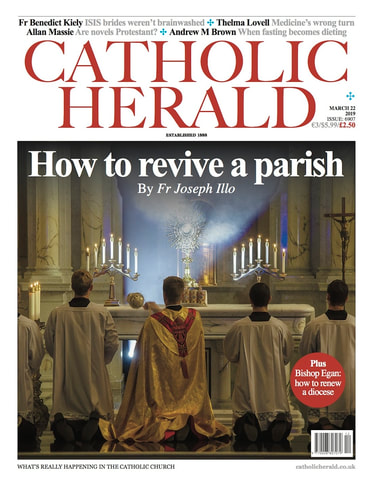 Mass attendance is up 12 per cent a year. Income has more than doubled. Here's what I've learned in the process Four years ago the Archbishop of San Francisco assigned me to the Star of the Sea, a large and beautifully Catholic building. Its statues, stained glass, marble altar and altar rail were still intact, but, like the entire parish, languishing in dilapidation. Mass attendance had dropped precipitously since the Italians and Irish began moving to the suburbs in the 1980s. The aggressive secularism of the last decade seemed to seal the fate of this once thriving parish, and the archdiocese began talking about a “merger”. The other day a priest who had served 10 years ago at Star of the Sea remarked on the parish’s “amazing revival”. Mass attendance has been growing annually at 12 per cent, and income has more than doubled. We’ve planted flowers and shrubs, installed new lighting, restored the marble sanctuary and flung the doors wide open to the city. The parish school begins an Integrated Classical Curriculum (consisting of grammar, logic and rhetoric) this autumn, and parishioners are caring for the homeless and advocating for the elderly and unborn. Mother Teresa famously said, however, that “we are called not to success but to fidelity”. Success and fidelity are essentially different categories, motivated as they are by different ends. While not demanding success, the Lord does expect the fruit of fidelity. His first command, to “be fruitful”, has never been abrogated, and “every branch that does not bear fruit will be cut off” (John 15:2). Christ promises 30, 60 and a hundredfold fruit to those who faithfully sow his Word. There is a way of measuring the revival of a parish, but it is not “success”. It is fruitfulness. Mass attendance and activities are good fruits, but the best fruit of any parish is healthy Catholic families. Are parishioners getting married and staying married? Are they having children? Are spouses faithfully living their sacramental vows, and is this fidelity reflected in their children’s lives? As healthy families are generational and need years of cultivation, a pastor may not see this fruit during his tenure. But he will see swifter fruits, such as increasing Mass attendance, blossoming schools and a zeal to serve the poor. We have seen both short and long-term fruits by building on St Prosper of Aquitaine’s three laws, the lex orandi (relating to prayer), lex credendi(belief) and lex vivendi (living). The way we pray determines the way we believe, which determines the way we live. Fidelity to these three laws provides Beauty, Truth and Goodness. In his first encyclical, Deus Caritas Est, Benedict XVI defined the three munera, or essential tasks, of the Church, governed by Prosper’s three laws. “The Church’s deepest nature,” he wrote, “is expressed in her three-fold responsibility: of proclaiming the word of God (kerygma-martyria), celebrating the sacraments (leitourgia) and exercising the ministry of charity (diakonia). These duties presuppose each other and are inseparable.” All parishes put time and money into all three tasks, but some focus disproportionately on kerygma (Catholic schools, dynamic preaching, social media), others on leitourgia (where either “progressive” or “traditional” liturgy becomes an obsession), and others on diakonia(“social justice” parishes). Mother Teresa, it seems to me, struck a healthy balance between orandi, credendi and vivendi. Her Missionaries of Charity pray four hours a day, but also study and teach continuously, and hit the streets daily in “wholehearted and free service to the poorest of the poor”. Let’s consider how a parish can balance these three essential tasks. The parish is first of all a school of prayer, in the words of John Paul II. It teaches prayer best by following the lex orandi which make liturgy beautiful. The Curé of Ars began his pastorate by spending money on new vessels and vestments for his country parish. Making everything in and around our churches bright, beautiful and clean is a priest’s first business. It’s as simple as following the General Instruction to the Roman Missal and reading the 2001 Vatican Instruction Liturgiam Authenticamclosely. Music, as the queen of the liturgical arts, requires particular attention. In music you get what you pay for, and people will pay for what they get. At one point we were spending 25 per cent of our budget on music, but our offertory increased by 50 per cent. This school of prayer must also provide the Sacrament of Penance, because we all make mistakes and can learn from them. Young adults flock to the parish mostly because we put a priest in the box at every Mass, and an hour every Tuesday night. Eucharistic Adoration seals the deal. We put $300,000 (£226,000) into a Eucharistic Chapel that burns brightly day and night. It’s worth every penny, because people need a beautiful place to pray before the Eucharistic Christ. The sacred liturgies must stir the soul with deep beauty. The parish must also be a school of God’s Word. Following the lex credendi through fidelity to the Church’s doctrine revives a parish because “my people are destroyed for lack of knowledge” (Hosea 4:6). After Beauty, we seek Truth. In our parish, priests teach children and priests teach adults, along with lay instructors. Besides the forthcoming Integrated Classical Curriculum, our school uses the Catechesis of the Good Shepherd, both proven effective in transmitting the kerygma. Homilies are expected to be good enough for publication and website posting, and our communications staff broadcast the Word through extensive use of social media, including a weekly bulletin for older folks. “How will they believe if they have not heard?” asks St Paul (Romans 10:14). The parish’s homilies, catechesis and school must stir the mind with deep truth. Finally, the parish is a school of service, following the lex vivendi. Beauty leads to Truth, and Truth leads to Goodness. Charity begins in the rectory, with priests taking meals together and praying a weekly “family rosary”. I require my priests (there are currently four of us) to pray lauds and vespers together every day in the church. Lay people always join us. Having ordered our lives together in charity, we can serve others. Our parish serves the very poorest of the poor by praying every week outside an abortion clinic. We feed the homeless every day from the rectory and join Mother Teresa’s Sisters regularly in the streets. A stewardship council articulates what St John Paul II called the “Law of the Gift”, which motivates all charitable giving. According to this law, we increase in the measure that we give, because life is about giving, not getting. The parish’s spirit of charitable service must stir the heart with goodness. Structuring the parish on the three laws of praying, believing and living guide the parish’s three essential tasks of Sacrament, Word and Charity. But there is a fourth way to revive a parish: let no parish forget Our Lady. “Is this the face that launched a thousand ships?” the poet spoke of the beautiful Helen. The Trojan War lasted 10 years, but we are engaged in a much longer struggle. It must be the face of Mary that launches pastoral action. My very first act in a new parish is to consecrate it to Our Lady. I myself lead the rosary processions, the Angelus before Mass and the rosary after Mass. No parish devoted to Our Lady will fail to bear fruit, because she is the mother of all the living. This morning a pounding rain woke me at 4am, but it wasn’t the rain that kept me tossing and turning. Yesterday, St. Joseph’s Day, I ran across one of our homeless men sitting in front of the parish office. He’s been coming for coffee and sandwiches for years, but unlike some of the more gregarious men, he is perpetually despondent. For the life of me I can’t remember his name, although he has told me, sadly, at least five times.
I have no problem remembering “Michael,” the young homeless guy who talks a mile a minute, a born salesman who has deftly convinced me to contribute a few hundred dollars to his cause over the years. I don’t forget “Mark’s” name, he who graduated from our school twenty years ago but is now a happy drunk living from hand to mouth in his old neighborhood. “Al” is a name I don’t forget, for he too has a philosophic approach to his lot in this life, looking forward to the next one. He says with a smirk that the streets of San Francisco are not all they are cracked up to be, at least for him and his buddies. But this sad man, who comes almost every day for a coffee and a sandwich—I can’t remember his name! His hair is long and greasy and stringy, and he has a tragic tumor bulging from the right side of his face. He has to wear glasses but they are usually broken or smudged. Yesterday morning, St. Joseph’s day, I came up to the office front door to find him waiting patiently for his daily bread. “Good morning!” I chirped, to which he made some sort of sad response. “Someone smashed the statue of Our Lady last night,” I noted, pointing to the empty spot where the Blessed Mother used to stand beside her homeless. He shook his head sadly and said “I guess they got the flower pot too….” Yes, I confirmed, “they threw that down the stairs too.” I guess he liked those flowers as much as I did. Not knowing what else to say, I commented on the amount of rain we’ve had this winter. “What do you do when it rains?” I asked. “I find a doorway,” he said plaintively. At that moment our faithful parish secretary appeared at the door with coffee and sandwiches. “Thank you,” he mumbled and shoved off. I went into the office to begin the day’s business. Tomorrow we will hear Christ’s parable of “Dives and Lazarus.” Lazarus is the homeless man languishing at the door of an unnamed rich man nicknamed “Dives” (the word for rich in Latin). The poor man at my door has no name, at least not one anyone can remember, but God knows this poor man’s name. His name is Lazarus, from the Hebrew Eleazar, meaning “God has helped.” In Christ’s parable, it is the rich man who has no name. I tossed and turned in a warm bed as the rain pounded outside this morning. Where was my Lazarus, and who would help him in the cold predawn streets of San Francisco? I can’t help him much, and in fact I can’t do much of anything. I couldn’t get back to sleep because, after thinking about Lazarus, the many problems afflicting my parish and my school swarmed over my helpless body. “Jesus help me,” I prayed over and over. “God help us.” Well, in fact, only God can help us. He will, I firmly believe, and He has, I firmly attest. But still, I can do something. I can learn my homeless man’s name. I can smile at him and give him an extra spoonful of sugar in his coffee this morning. God will have to do the rest, and I know He will. 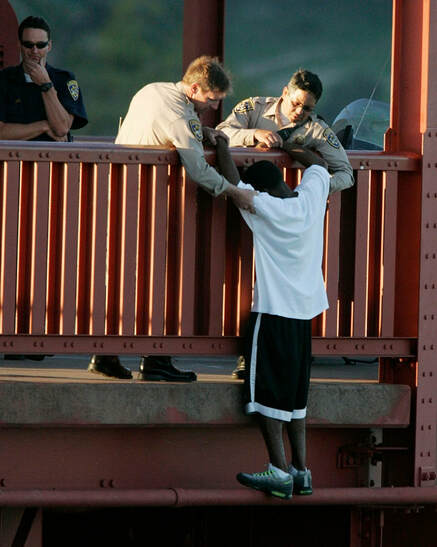 H/T: AP Photo/The San Francisco Chronicle, John Storey H/T: AP Photo/The San Francisco Chronicle, John Storey Yesterday I was riding across the Golden Gate Bridge with a friend. “They’ve begun building the suicide net,” I said, pointing over the left side of the roadway. We stopped our bikes to have a look. Amazingly, an entire superstructure had appeared beneath the bridge, suspended 230 feet above the Bay. After decades of debate, the City and County of San Francisco finally decided to build a steel-wire net under the bridge at a cost of $220 million. It is hoped that the net will save forty lives a year, which is about how many unfortunate souls hurl themselves over the bridge’s 4-foot railing annually. My parish boundaries include the southern half of the bridge, the San Francisco side, from which a person every ten days, on average, jumps to his or her death. Every First Friday we offer an afternoon Mass for their souls. Many times have I stopped my bike to peer down into the vast waters. The bridge affords an unimpeded view of sea lions cavorting far below, or container ships passing swiftly through the Golden Gate, or small craft battling current and wind in their search for fish or a good view. To the west an unlimited horizon of sea and sky meets my gaze, and I’ve often marveled how the waters beckon a troubled heart. I can certainly understand how one filled with troubles could cast themselves into that immense space to be swallowed up in beauty. The suicide net will extend about 25 feet out, blocking our view straight down. Maybe that will dissuade potential jumpers, but it will also eliminate the stunning view right below into the Bay. Eyeing the construction project, my cycling partner observed: how ironic that California decided to spend $200 million on suicide prevention in the same year it legalized suicide. How illogical, actually. Is suicide a good thing or a bad thing? Have we declared it a human right or is it still a crime? I blame our current confusion on poor education. For at least three generations Americans have not received the basic tools of learning, which by the way we are restoring to my parish school this autumn. “Grammar schools” used to be called that because they started first graders studying how language works. Grammar, logic, and rhetoric, the “trivium,” are the classic “three ways” of learning. Most Americans can scarcely discourse rationally on any subject because we lack the basic tools of critical thinking. Because we have lost the ability to think for ourselves, the powerful rule us by appealing to emotion (mostly our fears) and passion (mostly our lusts). $220 million to save forty lives a year is not unreasonable, but if we ordered our lives together better we would not need to build nets around our public monuments. It would be far better, far less expensive, and far more beautiful to spend our energies building a culture that encourages life rather than death. If every movie has to glamorize violent death, and death is the solution to unexpected pregnancies, and death by one’s own hand is celebrated (as media elites did with Brittany Maynard), then why build suicide nets? If we are in love with death, we will find other ways to kill ourselves. There is a better way. You don’t have to believe in Jesus as the Way, the Truth, and the Life to see in His beatitudes a solution to life’s problems. The solution is never death, but deeper life. “Blessed are the poor in spirit, for theirs is the Kingdom. Blessed are those who weep, for they shall laugh.” Every jumper that survives says that suicide is a mistake. There is far more good in life than bad. Maybe the suicide net will give people a second chance. But it would be far better to help people before they reach that level of despair.  Last month the governor of New York legalized abortion through the entire nine months of pregnancy and celebrated this law by lighting up the city’s tallest building in pink. Andrew Cuomo is on public record as saying “my Catholic faith is very important to me.” What responsibility does the Church have to correct grave injustice, and in particular, Catholic leaders who promote the killing of innocent human beings? Many Catholics assume abortion is not a grave evil because the bishops have not decisively corrected Catholic leaders who promote it. How many Catholics will gradually lose their faith, and how many Catholics will actually abort their children, because bishops do not correct Catholic officials who mock their own Church and destroy human life? Many laypeople have called for the excommunication of Governor Cuomo. Only bishops can exercise this “last resort” measure, designed to protect the faith of the people of God and bring the one excommunicated back to God. Cardinal Timothy Dolan, when asked why he has not corrected his son Andrew, laughed it off. “What clout do I have?” he joked. “I’m just a bald fat old man.” Is that really how a cardinal of the Church sees himself? The bishop of Albany, when asked why he has not formally corrected his son Andrew Cuomo, stammered and prevaricated a lame evasion along these lines: nobody really believes abortion is a good thing, and so I don’t have to excommunicate Governor Cuomo because he has already excommunicated himself from the public. “Why would I add insult to injury?” Bishop Scharfenberger said. Notice that the bishop treats abortion as a public relations issue, decided by popular opinion, rather than a moral issue. Public relations is more or less how the bishops have treated clergy sex abuse. Laudably, Bishop Scharfenberger has said some strong words against Governor Cuomo’s legislation, but the bishop has not followed his words with actions. Words are cheap. We are tired of words like “we will do everything we can to prevent clergy sexual abuse.” The bishops need to stop talking and start acting, acting like strong and brave fathers. But finally there is one bishop who has formally corrected any government leader who promotes the killing of unborn children. Bishop Thomas Daly, of Spokane, this week instructed all of his priests to withhold communion from any Catholic official who supports abortion. Finally, we have a father, a man who has decisively protected the faith of his children, a bishop who cares more for the souls of Catholic politicians than their approval. When Senator Ted Kennedy was asked how he, a Catholic, could support issues so clearly condemned by his own Church, he replied “it’s the bishop’s problem, not mine.” In other words, if the bishops really believed that abortion was a grave offence against human dignity, they would excommunicate me. Ted Kennedy was never formally disciplined by any of his bishops. Thank God we finally have a bishop, at least in Spokane, who is ready to suffer the personal attacks that will surely come to him from Catholic politicians in order to care for their souls. |
Fr. Joseph IlloStar of the Sea Parish, Subscribe to
|
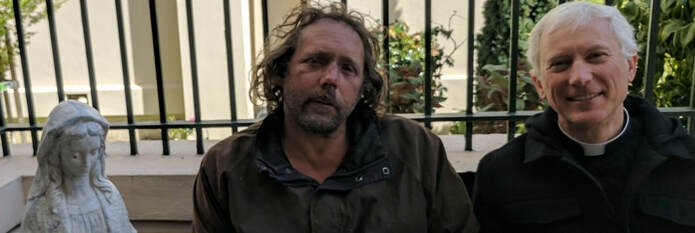
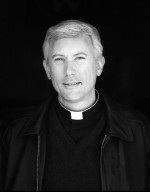

 RSS Feed
RSS Feed